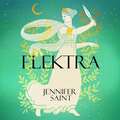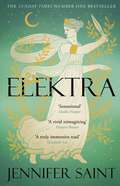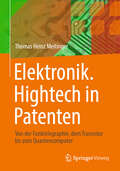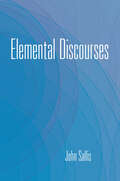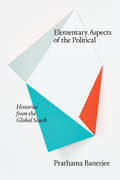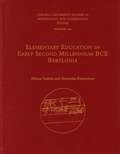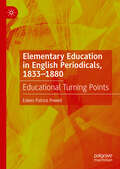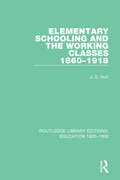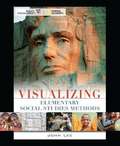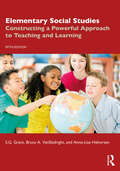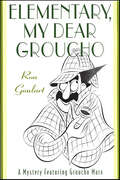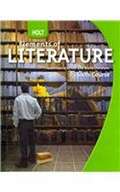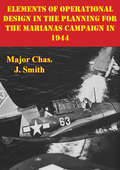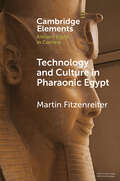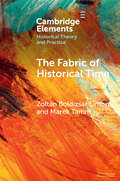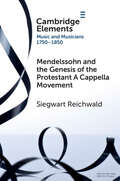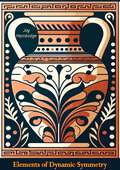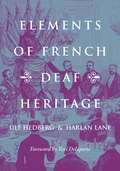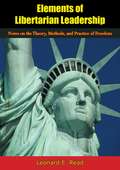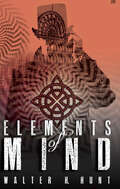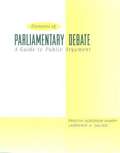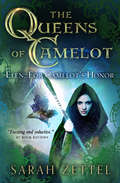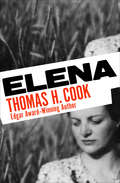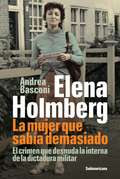- Table View
- List View
Elektra: The mesmerising retelling from the women at the heart of the Trojan War
by Jennifer Saint**The spellbinding new retelling of the Trojan War drawn from the perspective of the fearless women at the heart of it all.**'The story and its characters swept me up and engulfed me, I could not put this one down' ⭐ ⭐ ⭐ ⭐ ⭐ REAL READER REVIEW'I was glued to it from beginning to end and could not wait to recommend to my friends afterwards.' ⭐ ⭐ ⭐ ⭐ ⭐ REAL READER REVIEW'Jennifer Saint has breathed new life into this myth and put her own stamp on it' ⭐ ⭐ ⭐ ⭐ ⭐ REAL READER REVIEW'A brilliant read' Women & Home | 'A spirited retelling' Times | 'Beautiful and absorbing' Fabulous | 'A vivid reimagining of Greek mythology' Harper's Bazaar | 'Jennifer Saint has done an incredible job' RedThe House of Atreus is cursed. A bloodline tainted by a generational cycle of violence and vengeance. This is the story of three women, their fates inextricably tied to this curse, and the fickle nature of men and gods.ClytemnestraThe sister of Helen, wife of Agamemnon - her hopes of averting the curse are dashed when her sister is taken to Troy by the feckless Paris. Her husband raises a great army against them and determines to win, whatever the cost.CassandraPrincess of Troy, and cursed by Apollo to see the future but never to be believed when she speaks of it. She is powerless in her knowledge that the city will fall.ElektraThe youngest daughter of Clytemnestra and Agamemnon, Elektra is horrified by the bloodletting of her kin. But can she escape the curse, or is her own destiny also bound by violence?Praise for Jennifer Saint and ARIADNE:'A lyrical, insightful re-telling' Daily Mail'Relevant and revelatory' Stylist'Energetic and compelling' Times'An illuminating read' Woman & Home'A story that's impossible to forget' Culturefly
Elektra: The mesmerising story of Troy from the three women its heart
by Jennifer Saint**The spellbinding new retelling of the story of Troy drawn from the perspective of the fearless women at the heart of it all.**'The story and its characters swept me up and engulfed me, I could not put this one down' ⭐ ⭐ ⭐ ⭐ ⭐ REAL READER REVIEW'I was glued to it from beginning to end and could not wait to recommend to my friends afterwards.' ⭐ ⭐ ⭐ ⭐ ⭐ REAL READER REVIEW'Jennifer Saint has breathed new life into this myth and put her own stamp on it' ⭐ ⭐ ⭐ ⭐ ⭐ REAL READER REVIEW'A brilliant read' Women & Home | 'A spirited retelling' Times | 'Beautiful and absorbing' Fabulous | 'A vivid reimagining of Greek mythology' Harper's Bazaar | 'Jennifer Saint has done an incredible job' RedThe House of Atreus is cursed. A bloodline tainted by a generational cycle of violence and vengeance. This is the story of three women, their fates inextricably tied to this curse, and the fickle nature of men and gods.ClytemnestraThe sister of Helen, wife of Agamemnon - her hopes of averting the curse are dashed when her sister is taken to Troy by the feckless Paris. Her husband raises a great army against them and determines to win, whatever the cost.CassandraPrincess of Troy, and cursed by Apollo to see the future but never to be believed when she speaks of it. She is powerless in her knowledge that the city will fall.ElektraThe youngest daughter of Clytemnestra and Agamemnon, Elektra is horrified by the bloodletting of her kin. But can she escape the curse, or is her own destiny also bound by violence?Praise for Jennifer Saint and ARIADNE:'A lyrical, insightful re-telling' Daily Mail'Relevant and revelatory' Stylist'Energetic and compelling' Times'An illuminating read' Woman & Home'A story that's impossible to forget' Culturefly
Elektronik. Hightech in Patenten: Von der Funktelegraphie, dem Transistor bis zum Quantencomputer
by Thomas Heinz MeitingerElektronische Schaltungen werden heutzutage zumeist aus kristallinen Halbleitern hergestellt, in die Fremdatome eingebracht werden (Dotierung). Die Anfänge der Elektronik kennzeichnen jedoch die Elektronenröhren, mit denen die ersten gleichrichtenden und schaltenden Funktionen verwirklicht wurden. Die ersten, auf dieser Technologie basierenden Computer hatten eine geringe Leistung, wiesen dennoch gewaltige räumliche Ausmaße auf. Erst mit der Verwendung von dotierten Halbleitern begann die Miniaturisierung und die dynamische Entwicklung der Elektronik. Dieses Buch zeigt die Entwicklung der hierfür erforderlichen Elektronik von der Analogtechnik mit den Operationsverstärkern über die Digitaltechnik, die letzten Endes ins Computerzeitalter geführt hat, und der Hochfrequenztechnik, die entscheidend die Nachrichtenübertragung bestimmt hat, bis hin zur Leistungselektronik, die eine elektrische Energieversorgung ermöglicht. In diesem Buch werden die hierfür benötigten Erfindungen und die resultierende technische Entwicklung anhand der Hauptansprüche und Zeichnungen aus Patentschriften vorgestellt.
Elemental Discourses (The\collected Writings Of John Sallis Ser. #Ii, 4)
by John Sallis“A remarkable collection of essays that serve as a rewarding introduction to the more mature thought of Sallis . . . a feast of discourse.” —Notre Dame Philosophical ReviewsJohn Sallis’s thought is oriented to two overarching tasks: to bring to light the elemental in nature and to show how the imagination operates at the very center of human experience. He undertakes these tasks by analyzing a broad range of phenomena, including perception, the body, the natural world, art, space, and the cosmos. In every case, Sallis develops an original form of discourse attuned to the specific phenomenon and enacts a thorough reflection on discourse itself in its relation to voice, dialogue, poetry, and translation. Sallis’s systematic investigations are complemented by his extensive interpretations of canonical figures in the history of philosophy such as Plato, Aristotle, Kant, Schelling, and Hegel and by his engagement with the most original thinkers in the areas of phenomenology, hermeneutics, and deconstruction.
Elementary Aspects of the Political: Histories from the Global South (Theory in Forms)
by Prathama BanerjeeIn Elementary Aspects of the Political Prathama Banerjee moves beyond postcolonial and decolonial critiques of European political philosophy to rethink modern conceptions of "the political" from the perspective of the global South. Drawing on Indian and Bengali practices and philosophies from the late nineteenth and early twentieth centuries, Banerjee identifies four elements of the political: the self, action, the idea, and the people. She examines selfhood in light of precolonial Indic traditions of renunciation and realpolitik; action in the constitutive tension between traditional conceptions of karma and modern ideas of labor; the idea of equality as it emerges in the dialectic between spirituality and economics; and people in the friction between the structure of the political party and the atmospherics of fiction and theater. Throughout, Banerjee reasserts the historical specificity of political thought and challenges modern assumptions about the universality, primacy, and self-evidence of the political. In formulating a new theory of the political, Banerjee gestures toward a globally salient political philosophy that displaces prevailing Western notions of the political masquerading as universal.
Elementary Education in Early Second Millennium BCE Babylonia (CUSAS)
by Alhena Gadotti Alexandra KleinermanIn this volume, Alhena Gadotti and Alexandra Kleinerman investigate how Akkadian speakers learned Sumerian during the Old Babylonian period in areas outside major cities. Despite the fact that it was a dead language at the time, Sumerian was considered a crucial part of scribal training due to its cultural importance. This book provides transliterations and translations of 715 cuneiform scribal school exercise texts from the Jonathan and Jeanette Rosen Ancient Near Eastern Studies Collection at Cornell University. These tablets, consisting mainly of lexical texts, illustrate the process of elementary foreign-language training at scribal schools during the Old Babylonian period. Although the tablets are all without provenance, discrepancies between these texts and those from other sites, such as Nippur and Ur, strongly suggest that the texts published here do not come from a previously studied location. Comparing these tablets with previously published documents, Gadotti and Kleinerman argue that elementary education in Mesopotamia was relatively standardized and that knowledge of cuneiform writing was more widespread than previously assumed.By refining our understanding of education in southern Mesopotamia, this volume elucidates more fully the pedagogical underpinnings of the world’s first curriculum devised to teach a dead language. As a text edition, it will make these important documents accessible to Assyriologists and Sumerologists for future study.
Elementary Education in Early Second Millennium BCE Babylonia (CUSAS: Cornell University Studies in Assyriology and Sumerology #42)
by Alhena Gadotti Alexandra KleinermanIn this volume, Alhena Gadotti and Alexandra Kleinerman investigate how Akkadian speakers learned Sumerian during the Old Babylonian period in areas outside major cities. Despite the fact that it was a dead language at the time, Sumerian was considered a crucial part of scribal training due to its cultural importance. This book provides transliterations and translations of 715 cuneiform scribal school exercise texts from the Jonathan and Jeanette Rosen Ancient Near Eastern Studies Collection at Cornell University. These tablets, consisting mainly of lexical texts, illustrate the process of elementary foreign-language training at scribal schools during the Old Babylonian period. Although the tablets are all without provenance, discrepancies between these texts and those from other sites, such as Nippur and Ur, strongly suggest that the texts published here do not come from a previously studied location. Comparing these tablets with previously published documents, Gadotti and Kleinerman argue that elementary education in Mesopotamia was relatively standardized and that knowledge of cuneiform writing was more widespread than previously assumed.By refining our understanding of education in southern Mesopotamia, this volume elucidates more fully the pedagogical underpinnings of the world’s first curriculum devised to teach a dead language. As a text edition, it will make these important documents accessible to Assyriologists and Sumerologists for future study.
Elementary Education in English Periodicals, 1833-1880: Educational Turning Points
by Edwin Patrick PowellThe nature and purpose of elementary education featured prominently in English periodicals throughout the nineteenth century. This book’s central argument is that the periodical press provided a unique cultural space for literary and intellectual contributions to sustained debates about education. Furthermore, political, economic, social, religious, literary, and cultural developments converged with pivotal educational turning points featured in periodicals that affirmed the creative force of education. However, relatively little scholarly attention has been given to periodicals as a medium for exploring the tension between competing educational ideas and practices in Victorian England. This book therefore reassesses elementary education through the new literary perspectives of periodical culture.
Elementary Schooling and the Working Classes, 1860-1918 (Routledge Library Editions: Education 1800-1926 #8)
by J. S. HurtThis study, first published in 1979, analyses the attitude of various income and occupational groups to elementary schools both before and after the introduction of compulsory school attendance. It also discusses the efforts made by voluntary organisations to provide school meals, as well as examining the quality of the meals themselves, before the enactment of remedial legislation in the early twentieth century. This title will be of interest to students of history and education.
Elementary Social Studies Methods
by John K. LeeAn excellent resource for social studies teachers, this book will help them learn about and reflect on their responsibilities in our society. It focuses on classroom-based experiences and real-world contexts. The teaching methods discussed are also closely associated to social studies subject matter so they can be integrated into the actual classroom. Each chapter also examines how social studies is situated within the larger elementary curriculum to demonstrate the interdisciplinary nature of the instruction.
Elementary Social Studies: Constructing a Powerful Approach to Teaching and Learning
by Bruce A. VanSledright S.G. Grant Anne-Lise HalvorsenThe fully updated fifth edition of Elementary Social Studies provides a rich and ambitious framework to help social studies teachers achieve powerful teaching and learning results. Organized around four commonplaces of education—learners and learning, subject matter, teachers and teaching, and classroom environment—and deeply rooted in inquiry-based teaching and learning, this book deeply probes the basic elements of quality instruction—planning, implementation, and assessment—always with the goal of creating and supporting students who are motivated, engaged, and thoughtful.Book features and updates to the fifth edition include: • New guidance on tackling controversial issues in the social studies classroom. • Fully revised chapter on creating a genuine learning community, which now addresses socio-emotional learning and family involvement in the classroom. • New perspectives on the importance of teaching for social justice. • Increased attention to the C3 Framework for state social studies standards. • Chapters on using the Inquiry Design Model (IDM) to understand inquiry-based teaching and learning and to develop IDM inquiries. • Real-classroom narratives that introduce chapters and provide in-depth access to teaching and learning contexts. • Practical curriculum and resource suggestions for the social studies classroom. • End-of-chapter summaries and annotated teaching resources.By blending the theoretical and the practical, this book is essential reading for pre-service and in-service social studies teachers.
Elementary, My Dear Groucho: A Mystery featuring Groucho Marx (Private Eye Groucho Marx)
by Ron GoulartWhen a body is found in Holmes's 221B Baker Street lodgings on the set at Mammoth Studios during the shooting of The Valley of Fear, Groucho Marx and his sidekick Frank Denby begin investigating, in Ron Goulart's hilarious mystery Elementary, My Dear Groucho. The victim is the German emigre director of the movie who was found in the great detective's favorite armchair, stabbed in the chest with Holmes's pearl-handled letter opener. There is another murder but it takes more than murder to stifle Groucho's quips or to quiet the laughter this surprising reincarnation inspires. "Chance meetings with celebrities and Groucho's constant wordplay keep the action light and snappy." - Publishers Weekly
Elements Of Literature: Essentials Of British And World Literature, Sixth Course (Holt Elements Of Literature Ser.)
by Beers Rinehart And Winston HoltElements of Literature; Essentials of British and World Literature, sixth course, 2009 1st Edition
Elements Of Operational Design In The Planning For The Marianas Campaign In 1944
by Major Chas. J. SmithOperational art and the operational level of war became a doctrinal focus for the U.S. Army in the 1980s. This focus led to the development of the elements of operational design. These concepts are not new, and were developed in the interwar period prior to World War II at the staff and war colleges. During this time, however, the military did not doctrinally recognize the operational level or war or operational art. Even though the concepts were not recognized, the intellectual process permeated the officer education system prior to World War II. Clearly, American officers in World War II used something of operational art, including in the planning and execution of the Marianas Campaign. This monograph looks at the question in more detail, by testing the extent to which planners within CENPAC used the elements of operational design in the Marianas Campaign, including end state and objectives, effects, center(s) of gravity, decisive points, direct and indirect action, lines of operation, operational reach, simultaneity and depth, timing and tempo, leverage, balance, anticipation, culmination, and arranging operations. The implication of this study is that as current doctrine evolves, the development, education, and execution of operational concepts in the World War II era continue to be useful.
Elements in Ancient Egypt in Context: Actor Network Theory And The Archaeology Of Things And People (Elements In Ancient Egypt In Context Ser.)
by Martin FitzenreiterElements in Historical Theory and Practice: The Fabric of Historical Time (Elements In Historical Theory And Practice Ser.)
by Marek Tamm Zoltán Boldizsár SimonElements in Music and Musicians 1750–1850: Mendelssohn and the Genesis of the Protestant A Cappella Movement (Elements In Music And Musicians 1750-1850 Ser.)
by Siegwart ReichwaldElements of Dynamic Symmetry (Dover Art Instruction Ser.)
by Jay HambidgeUnlock the secrets of nature's inherent harmony with Jay Hambidge's seminal work, Elements of Dynamic Symmetry. This groundbreaking book introduces readers to the principles of dynamic symmetry, a system of proportion and design that underlies the natural world and has been used by artists, architects, and designers throughout history to create aesthetically pleasing and harmonious compositions.Jay Hambidge, a pioneer in the study of geometric proportion, presents a comprehensive exploration of dynamic symmetry, tracing its origins and applications across various fields. Through clear explanations, detailed diagrams, and insightful analysis, Hambidge demonstrates how these principles can be applied to achieve balance and beauty in art and design.Elements of Dynamic Symmetry delves into the mathematical foundations of this system, exploring the ratios and relationships that govern dynamic symmetry. Hambidge illustrates how these principles can be found in natural forms, from the spirals of shells to the branching of trees, and how they have been employed in the masterpieces of classical and modern art, from ancient Greek temples to Renaissance paintings.Elements of Dynamic Symmetry is an essential read for artists, architects, designers, and anyone interested in the intersection of art, mathematics, and nature. Hambidge's pioneering work continues to inspire and inform, offering timeless insights into the universal principles of beauty and harmony.Join Jay Hambidge on a journey through the elements of dynamic symmetry and discover how these principles can transform your understanding of design and aesthetics. This classic text remains a cornerstone in the study of proportion and a testament to the enduring power of geometric harmony in the creation of art.
Elements of French Deaf Heritage
by Harlan Lane Ulf HedbergFrench Deaf culture is regarded as a major influence on the formation of other Deaf cultures around the world, notably American Deaf culture. In Elements of French Deaf Heritage, Ulf Hedberg and Harlan Lane document the development of Deaf culture in France by way of Deaf schools, Deaf associations, private and professional networks, publishing, and the arts. This highly visual work captures these forces from the late 18th century through the end of the 19th century, when cultural formation began to shift to cultural maintenance. Encyclopedic in scope, this examination of the evolution of Deaf ethnicity in France aims to disseminate an extensive amount of archival information, now available for the first time in the English language.
Elements of Libertarian Leadership: Notes on the Theory, Methods, and Practice of Freedom
by Leonard E. ReadIn this book, first published in 1962, the author and founder of the Foundation for Economic Education, Leonard E. Read, skilfully organizes his numerous, previously published FEE materials into a single, usable manual “for those who would give liberty a hand.”“The emphasis in this volume is on methodology. Assuming an individual has mastered the philosophical aspects of freedom, what can he do about it? With whom does he work? What are his limitations? His potentialities?”—Leonard E. Read, Foreword
Elements of Mind
by Walter H. HuntA doctor in Victorian India who performs surgery using mesmerism and drawing power from an artifact commits suicide before delivering the artifact to Rev. William Davey at the Committee of English Mesmerists, prompting Davey on a quest. Davey uncovers much more than just an artifact. The chthonoi, ancient, banished, elemental spirits now seek to open the glass Door and reassert themselves in the word of man.
Elements of Parliamentary Debate: A Guide to Public Argument
by Lawrence Galizio Trischa KnappElements of Parliamentary Debate: A Handbook is the first complete guide available to students on parliamentary debate. The brief handbook covers the basics of parliamentary debate in an easy-to-use and flexible format. Topics covered include debate preparation, resolution analysis, case construction, refutation, argumentation, and delivery and adjudication. As a text or supplement, Elements of Parliamentary Debate offers a handy reference guide to students, instructors and coaches interested in, or now practicing, parliamentary debate.
Elen: For Camelot's Honor (The Queens of Camelot #2)
by Sarah ZettelIn this romantic fantasy from the award-winning author of Reclamation, a Welsh chieftain’s daughter and an Arthurian knight battle a vile sorceress. Steel and sorcery collide in this epic series featuring the women of Camelot. When treachery and violence destroy Elen’s homeland, a power begins to rise inside her. But it will take more than that untested magic to avenge her family, unite her people, and reclaim their land. Her enemy receives power from an evil source: the wicked sorceress Morgaine LeFay, who will stop at nothing to destroy King Arthur and his knights of Camelot. And she plans to use Elen to work for her own vile purpose. The thought of Elen in danger stirs something in the heart of Sir Geraint. Quiet and stalwart, he has always remembered the warmth they once shared. He will do anything to help her, even traveling undercover into enemy territory, where his martial skill and the love he shares with Elen will be put to the ultimate test . . . Praise for Elen: For Camelot’s Honor “Lyrical, heartwarming, and engaging.” —Explorations “Fine characterizations, lyrical writing, and intricate plotting make for a spellbinding journey.” —BookLoons Reviews
Elena
by Thomas H. CookA brother recalls the magnificent life of his sister, the greatest writer of her ageA launch party is underway for a hotly anticipated biography, the life story of Elena Franklin. As a young woman, Elena was one of the most promising literary talents of the 1920s, and over the years her legend grew. Her biographer, Martha Farrell, has combed through all the evidence of Elena&’s genius and passion, from her early years in New York to her expatriate life in Paris. The result is a monumental work – but among the party&’s crowd is the man who knows the book is an empty shell. Only William, Elena&’s brother, knew the truth about the famed author. Martha&’s flawed biography spurs his memory, and he recalls how the temperamental baby grew into a legend. He knew Elena&’s hidden pain, shared their family secrets, and draws his own portrait of the troubled soul that lay behind her artistic gifts.
Elena Holmberg. La mujer que sabía demasiado: El crimen que desnuda la interna de la dictadura militar
by Andrea BasconiEl caso Holmberg desnuda la historia de una víctima poco usual para ladictadura militar: ella era una de ellos. «Ando en problemas con los marinos del ministerio», le dijo ElenaHolmberg a su hermano, unos días antes de que su cuerpo aparecieraflotando en el río Luján, a la altura de Tigre. Elena era diplomática decarrera, hija de una familia patricia argentina y prima hermana del expresidente de facto Alejandro Agustín Lanusse. Una mujer de derechaconservadora confesa. Antiperonista y contraria a cualquiermanifestación de izquierda. Trabajó desde 1972 en la embajada argentinaen París, donde más tarde estuvo al mando del Centro Piloto, hasta queen los últimos meses de 1978 se ordenó sorpresivamente su traslado aBuenos Aires.Esta apasionante investigación periodística de Andrea Basconi, narradacomo si fuera una novela, reconstruye qué sucedió desde que a Elena laobligaron a subir a un Chevy que huyó a toda velocidad por la calleUruguay.¿Qué sabía Elena que era tan comprometedor para el almirante Massera? ¿Hasta dónde llegaron las esquirlas del delirio de poder y las internasde la última dictadura militar? Si Massera no se había reunido con lacúpula montonera y no les había pagado un millón de dólares paragarantizarse una alianza que terminara por destrozar a su enemigoíntimo, como sostenía Elena, ¿por qué los marinos la eliminaron luego delas reuniones de la funcionaria con sus confidentes?
